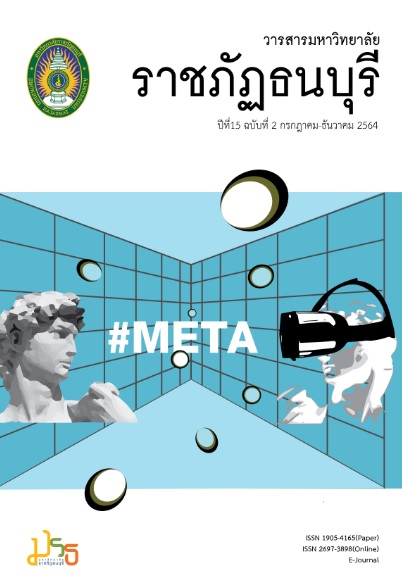การเพิ่มความจำขณะคิดสำหรับเด็กปฐมวัยที่เสี่ยงต่อภาวะความบกพร่องทางคณิตศาสตร์ด้วยโปรแกรมส่งเสริมพัฒนาการทางตัวเลขร่วมกับปัญญาสมานกาย
คำสำคัญ:
ความจำขณะคิด, เด็กที่เสี่ยงต่อภาวะความบกพร่องทางคณิตศาสตร์, ปัญญาสมานกายบทคัดย่อ
การวิจัยนี้มีวัตถุประสงค์เพื่อเปรียบเทียบความจำขณะคิดของเด็กปฐมวัยที่เสี่ยงต่อภาวะความบกพร่องทางคณิตศาสตร์หลังใช้วิธีการสอนด้วยโปรแกรมส่งเสริมพัฒนาการทางตัวเลขร่วมกับปัญญาสมานกายและวิธีการสอนด้วยการใช้กิจกรรมในชั้นเรียนปกติ กลุ่มตัวอย่างเป็นนักเรียนระดับชั้นอนุบาล 3 ที่เสี่ยงต่อภาวะความบกพร่องทางคณิตศาสตร์ที่ผ่านการคัดกรอง จำนวน 100 คน ซึ่งแบ่งเป็น 2 กลุ่มๆ ละ 50 คน โดยใช้วิธีการสุ่มอย่างง่าย เครื่องมือที่ใช้ในการวิจัยครั้งนี้เป็นวิธีการสอนด้วยโปรแกรมส่งเสริมพัฒนาการทางตัวเลขร่วมกับปัญญาสมานกาย กิจกรรมทดสอบความจำขณะคิดด้านตัวเลขแบบย้อนกลับและกิจกรรมทดสอบด้านมิติสัมพันธ์แบบย้อนกลับ วิเคราะห์ข้อมูลโดยใช้สถิติพื้นฐาน วิเคราะห์ความแปรปรวนร่วมพหุคูณ (One-way MANCOVA) และค่าขนาดอิทธิพล (Effect Size) ผลการวิจัยปรากฎว่า เด็กปฐมวัยที่เสี่ยงต่อภาวะความบกพร่องทางคณิตศาสตร์ เมื่อจำแนกตามกลุ่มที่ใช้โปรแกรมส่งเสริมพัฒนาการทางตัวเลขร่วมกับปัญญาสมานกายกับกลุ่มที่ใช้กิจกรรมในชั้นเรียนปกติ มีค่าเฉลี่ยคะแนนความถูกต้องด้านตัวเลขของความจำขณะคิดหลังการทดลองแตกต่างกัน อย่างมีนัยสำคัญทางสถิติที่ระดับ .05 แสดงว่า โปรแกรมส่งเสริมพัฒนาการทางตัวเลขร่วมกับปัญญาสมานกายสามารถเพิ่มความจำขณะคิดด้านตัวเลขของเด็กปฐมวัยที่เสี่ยงต่อภาวะความบกพร่องทางคณิตศาสตร์ และขนาดอิทธิพลอยู่ในระดับมาก (ηp2) = 0.28
Downloads
เอกสารอ้างอิง
พีร วงศ์อุปราช. (2560). รายงานการวิจัยโครงการการศึกษาเชิงจิตประสาทวิทยาและการพัฒนาแบบคัดกรองเน้นกระบวนการทางปัญญาในเด็กที่เสี่ยงต่อภาวะความบกพร่องทางการเรียนรู้ด้าน
คณิตศาสตร์ . ชลบุรี : มหาวิทยาลัยบูรพา.
สถาบันส่งเสริมการสอนวิทยาศาสตร์และเทคโนโลยี (สสวท.). (2561). ผลการประเมิน PISA 2015 วิทยาศาสตร์การอ่าน และคณิตศาสตร์ ความเป็นเลิศ และความเท่าเทียมทางการศึกษา.
กรุงเทพฯ : สถาบันส่งเสริมการสอนวิทยาศาสตร์และเทคโนโลยี(สสวท.) กระทรวงศึกษาธิการ.
Ashcraft, M. H., & Ridley, K. S. (2005). Math anxiety and its cognitive consequences: A tutorial review, p. 50
Butterworth, B. (2005). Developmental dyscalculia. In J. I. D. Campbell (Ed.) Decision SupportSystems (pp. 455–467): Handbook of mathematical cognition (Hove, UK: Psychology Press).
Cantlon, J. F., Brannon, E. M., Carter, E. J., & Pelphrey, K. A. (2006). Functional imaging of numerical processing in adults and 4-y-old children. PLoS biology, 4 (5), p. 125.
Dackermann, T., Fischer, U., Nuerk, H.-C., Cress, U., & Moeller, K. (2017). Applying embodiedcognition: from useful interventions and their theoretical
underpinnings to practical applications. Zdm, 49 (4), pp. 545-557.
Ehrler, D. J., & McGhee, R. L. (2008). PTONI: Primary test of nonverbal intelligence: Pro-Ed Austin, TX.
Geary, D. C., Bailey, D. H., & Hoard, M. K. (2009). Predicting mathematical achievement and mathematical learning disability with a simple screening tool: The
Number Sets Test. Journal of Psychoeducational Assessment, 27, pp. 265–279.
Glenberg, A. M. (2010). Embodiment as a unifying perspective for psychology. Wiley Interdisciplinary Reviews: Cognitive Science, 1 (4), pp. 586-596.
Hair, J.F., Black, W.C., Babin, B.J., Anderson, R.E. (2010). Multivariate Data Analysis. (7th Edition). NJ : Prentice Hall.
Jordan, N. C., Kaplan, D., Ramineni, C., & Locuniak, M. N. (2009). Early math matters: Kindergarten number competence and later mathematics outcomes. Developmental psychology, 45 (3), p. 850.
Kaufmann, L. (2008). Dyscalculia: neuroscience and education. Educational research; a review for teachers and all concerned with progress in education, 50 (2),
pp. 163-175.
Kaufmann, L., Mazzocco, M.M., Dowker, A., von Aster, M., Gobel, S.M., Grabner, R.H., & Nuerk, H.C. (2013). Dyscalculia from a developmental and differential perspective. Frontiers in Psychology, 4, pp. 106-113.
Kucian, K., Grond, U., Schönmann, C., Henzi, B., Rotzer, S., Gälli, M., & Aster, M. v. (2010). Training in children with developmental dyscalculia. International Journal of Psychophysiology, 77 (3), p. 228.
Layes, S., Lalonde, R., Bouakkaz, Y., & Rebai, M. (2018). Effectiveness of working memory training among children with dyscalculia: evidence for transfer effects on
mathematical achievement-a pilot study. Cognitive processing, 19 (3), pp. 375-385.
Montoya, M. F., Susperreguy, M. I., Dinarte, L., Morrison, F. J., San Martín, E., Rojas-Barahona, C. A., & Förster, C. E. (2019). Executive function in Chilean preschool
children: Do short-term memory, working memory, and response inhibition contribute differentially to early academic skills?. Early Childhood Research Quarterly, 46, pp. 187-200.
Newcombe, N. S., Levine, S. C., & Mix, K. S. (2015). Thinking about quantity: The intertwined development of spatial and numerical cognition. Wiley Interdisciplinary Reviews: Cognitive Science, 6 (6), pp. 491-505.
Oh-Uchi, A., Kawahara, J.-i., & Sugano, L. (2010). Attentional capture and metaattentional judgment:a study of young children, parents, and university students. Psychologia, 53 (2), pp. 114-124.
Oviatt, S., Lin, J., & Sriramulu, A. (2021). I know what you know: What hand movements reveal about domain expertise. ACM Transactions on Interactive Intelligent Systems, 11 (1). pp. 1-26.
Passolunghi, M. C., & Siegel, L. S. (2004). Working memory and access to numerical information in children with disability in mathematics. Journal of Experimental Child Psychology, 88 (4), pp. 348-367.
Passolunghi, M. C., & Costa, H. M. (2016). Working memory and early numeracy training in preschool children. Child Neuropsychology, 22, pp. 81–98.
Raghubar, K. P., Barnes, M. A., & Hecht, S.A. (2010). Working memory and mathematics: A review of developmental, individual difference, and cognitive approaches.Learning and Individual Differences, 20 (2), p. 113.
Schaefer, S. (2018). Embodiment Helps Children Solve a Spatial Working Memory Task: Interactions with Age and Gender. Journal of Cognitive Enhancement, 3,
p. 105.
Schaefer, S. (2019). Embodiment Helps Children Solve a Spatial Working Memory Task: Interactions with Age and Gender. J Cogn Enhanc, 3, pp. 233–244.
Shalev, R. S., & Gross-Tsur, V. (2001). Developmental dyscalculia. Pediatric neurology, 24 (5), pp. 337-342.
Swanson, H. L. (2006). Cross-sectional and incremental changes in working memory and mathematical problem solving. Journal of Educational Psychology, 98 (2),
p. 265.
Turoman, N., Tivadar, R. I., Retsa, C., Maillard, A. M., Scerif, G., & Matusz, P. J. (2021). The development of attentional control mechanisms in multisensory
environments. Developmental Cognitive Neuroscience, 48, pp. 1-14.
ดาวน์โหลด
เผยแพร่แล้ว
รูปแบบการอ้างอิง
ฉบับ
ประเภทบทความ
สัญญาอนุญาต
ลิขสิทธิ์ (c) 2021 มหาวิทยาลัยราชภัฏธนบุรี

อนุญาตภายใต้เงื่อนไข Creative Commons Attribution-NonCommercial-NoDerivatives 4.0 International License.
บทความที่ได้รับการตีพิมพ์เป็นลิขสิทธิ์ของมหาวิทยาลัยราชภัฏธนบุรี
ข้อความที่ปรากฏในบทความแต่ละเรื่องในวารสารวิชาการเล่มนี้เป็นความคิดเห็นส่วนตัวของผู้เขียนแต่ละท่านไม่เกี่ยวข้องกับมหาวิทยาลัยราชภัฏธนบุรีและบุคลากรท่านอื่น ๆ ในมหาวิทยาลัยฯ แต่อย่างใด ความรับผิดชอบองค์ประกอบทั้งหมดของบทความแต่ละเรื่องเป็นของผู้เขียนแต่ละท่าน หากมีความผิดพลาดใด ๆ ผู้เขียนแต่ละท่านจะรับผิดชอบบทความของตนเองแต่ผู้เดียว







